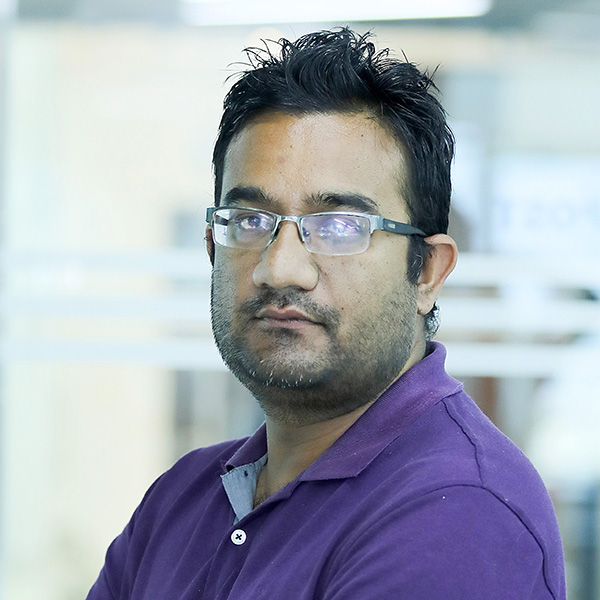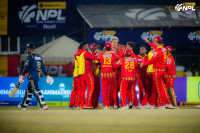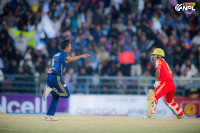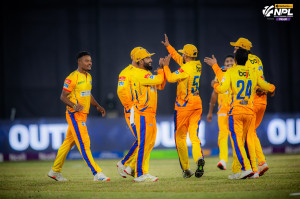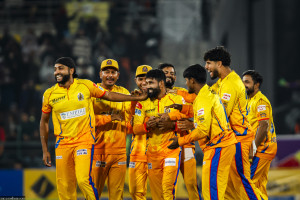Sports
Nepal has a hockey team. But it doesn’t have a single hockey field.
If the condition of hockey infrastructure is any indication, then it’s no surprise that Nepal’s international appearance in hockey—especially in the South Asian Games—has equally been a debacle.
Adarsha Dhakal
When Satya Narayan Chaudhary, the captain of the Army Club’s hockey team, took up the sport over a decade ago, he had imagined playing in a smooth green field—just like they do in most countries where the sport is popular. But to his dismay, Chaudhary has never had a chance to see a proper hockey field at home.
“My entire career in hockey has been spent playing on a terrible field,” Chaudhary said. “It is only during international tournaments we get to see a proper, green hockey field.”
This week, 38-year-old Chaudhary was playing his last domestic game in the National Games final. He led the Army team to its eighth National Games gold on Tuesday, beating their departmental archrivals Nepal Police Club in a penalty shootout after the game ended in a tie during the regular 70 minutes.
For a moment, the Army dugout at the Mangal Prasad Higher Secondary School ground went through a jubilant celebration, but soon, the reality hit them. For the Army team and most Nepali hockey players, it’s a routine thing—the game has always been organised in haste and without proper infrastructure for decades. No one knows what's next in store for the hockey players after the National Games are over.
Hockey is played in Nepal without a proper field. Chaudhary says the ground where his team usually trains, at the Army Physical Fitness and Training Centre in Lalitpur, has the best surface for the game. But it’s not a hockey field—it’s for football.
“This is the worst surface we have ever played on,” said Chaudhary, after his team's gold medal triumph at the high school ground that has barely any grass. On any other day, the ground also plays host to cricket or football tournaments. It is, in fact, so overused and least looked after that the ground is not suitable for any sports.
“The surface is very hard because there is no grass. We don’t have any idea when the ball bounces. On a surface like this, we can’t make a proper run and have a high chance of getting injured,” Chaudhary said.
If the condition of hockey infrastructure is any indication, then it’s no surprise that Nepal’s international appearance in hockey—especially in the South Asian Games—has equally been a debacle. The national team conceded 79 goals when men's hockey was last included in the 2010 edition in Dhaka. Their biggest defeat so far is 24-0 against Bangladesh in 2010, when they scored only one goal throughout the tournament.
In modern-day hockey, the game is played in three surfaces, all of which have to be extraordinarily smooth. For outdoor hockey, traditionally, the grass makes the best field; indoor hockey is played on a synthetic surface. In recent years, astroturfs have replaced the grass field in outdoor hockey.
At the National Games, the women’s hockey field, hosted at the Shukra Secondary School, was comparatively worse. Athletes could not even spot the ball during an on-field challenge because it would get invisible in the puff of dust.
But it is not just the scarcity of a proper field Nepali hockey players have to deal with. Today, the sport neither has quality players nor coaches or match officials. The final between the Army and the Police was officiated by a referee imported from India. The Police team includes a few Nepalis who were raised in India and play the sport there. Many Hindi-speaking Nepalis crossed the border just to play in the National Games.
Former national player Shafiq Ahmed Siddiqui, now a treasurer with Banke District Hockey Association, said getting players from India during big games won’t help the sport’s future in the country. “These boys play in India because there are better opportunities for them,” said Siddiqui. “Nepal has to produce its own players to make sure the game goes on.”
For Siddiqui, it’s a frustrating sign that none of the representatives from the local organising committee of the National Games was present to monitor the tournament. “The district association doesn't have a bank account and the central body doesn’t have any plan,” Siddiqui told the Post. “The National Sports Council has no idea how it needs to think about hockey.”
The country hosted its eighth National Games after the government finally released Rs850 million to the local organising committee. But hockey, for which an astroturf could have been procured for Rs3.5 to Rs4 million, only received around Rs 250,000.
“That was the only budget allocated for hockey and we had to make do with the grounds that were available,” said Bhim Oli, coordinator of the venue management committee.
Later this year, Nepal is supposed to host the South Asian Games—but only if the country can complete the construction of all infrastructure on time. Even if most facilities will be finished on time, Nepal will still not have a proper field designated for hockey—one of the 27 games in the event.
“We are hosting a big tournament but I don’t know where we’re going to play hockey,” Chaudhary said. “But if the government actually wanted, it’s not too late to build a proper facility before the impending games.”




 13.12°C Kathmandu
13.12°C Kathmandu